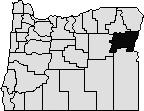
Baker County was created from part of Wasco County in 1862. It was named for
Edward Baker, one of Oregon's first senators and a colonel in the
Union Army. Baker was killed at the Battle of Balls Bluff in 1861. In 1864
Union County was created from the northern portion of the county. In 1887
Malheur County was created from the southern portion of the county. The boundaries were adjusted for the last time in 1901 when the area between the Powder River and the Wallowa Mountains, known as the Panhandle, was returned to Baker County.
The county consists of 3,089 square miles and is bounded to the north by Union and Wallowa Counties, to the west by Grant County, to the south by Malheur County, and to the east by the State of Idaho. The original county seat was established at Auburn. Originally a booming mining town with 5,000 inhabitants, the population dwindled and there was agitation to move the county seat. In 1868 an election confirmed Baker City as the new county seat.
The county has had three courthouses, all occupying the same site. The first courthouse was a two-story wooden structure built in 1869. It was replaced by a brick building in 1885. The current courthouse is a three-story building completed in 1909. It is constructed of a gray volcanic stone quarried a few miles south of town. Original county officers included a county judge, two commissioners, sheriff, clerk, treasurer, assessor and school superintendent.
Gold mining was the original drive for settlement in the area. At one time the county was the largest gold producer in the Northwest. Agriculture, stock raising, logging and tourism have become the primary economic pursuits. The Oregon Trail Interpretative Center has drawn large numbers of visitors since it opened in 1993 on Flagstaff Hill
northeast of Baker City. The Eagle Cap Wilderness Area, Hells Canyon Recreation Area, Sumpter Gold Dredge Park, Baker City Restored Historic District, and Anthony Lakes Ski Resort, along with fishing and hunting, also draw visitors to the area.
The county's population has fluctuated due in part to the boom and bust nature of mining. The population in 2008 of 16,455 represented a 1.7%
decrease from 2000 and was down from a high of 17,295 in 1960.